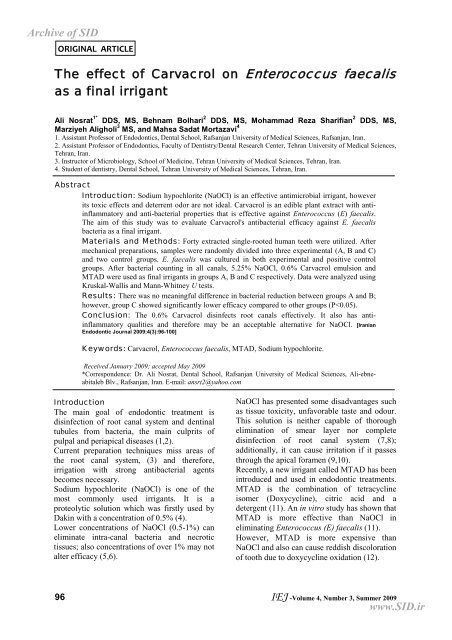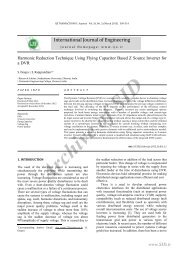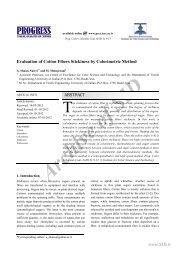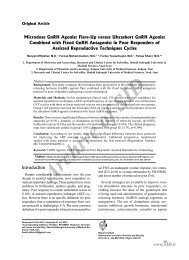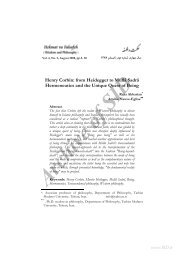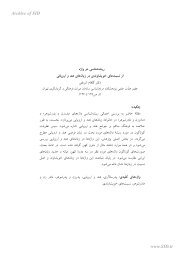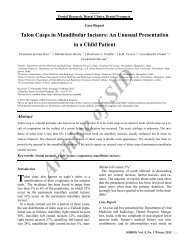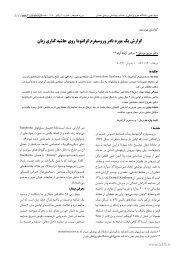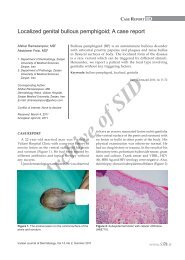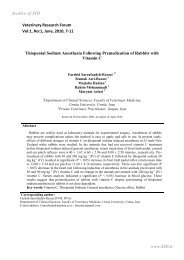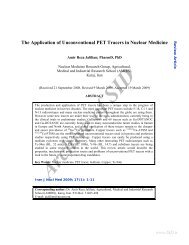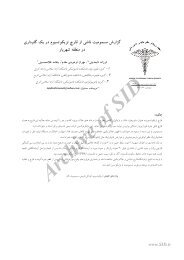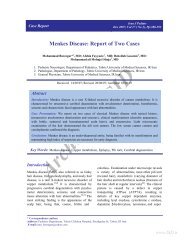THE EFFECT OF CARVACROL ON ENTEROCOCCUS FAECALIS ...
THE EFFECT OF CARVACROL ON ENTEROCOCCUS FAECALIS ...
THE EFFECT OF CARVACROL ON ENTEROCOCCUS FAECALIS ...
You also want an ePaper? Increase the reach of your titles
YUMPU automatically turns print PDFs into web optimized ePapers that Google loves.
Archive of SID<br />
ORIGINAL ARTICLE<br />
The effect of Carvacrol on Enterococcus faecalis<br />
as a final irrigant<br />
Ali Nosrat 1* DDS, MS, Behnam Bolhari 2 DDS, MS, Mohammad Reza Sharifian 2 DDS, MS,<br />
Marziyeh Aligholi 3 MS, and Mahsa Sadat Mortazavi 4<br />
1. Assistant Professor of Endodontics, Dental School, Rafsanjan University of Medical Sciences, Rafsanjan, Iran.<br />
2. Assistant Professor of Endodontics, Faculty of Dentistry/Dental Research Center, Tehran University of Medical Sciences,<br />
Tehran, Iran.<br />
3. Instructor of Microbiology, School of Medicine, Tehran University of Medical Sciences, Tehran, Iran.<br />
4. Student of dentistry, Dental School, Tehran University of Medical Sciences, Tehran, Iran.<br />
Abstract<br />
Introduction: Sodium hypochlorite (NaOCl) is an effective antimicrobial irrigant, however<br />
its toxic effects and deterrent odor are not ideal. Carvacrol is an edible plant extract with antiinflammatory<br />
and anti-bacterial properties that is effective against Enterococcus (E) faecalis.<br />
The aim of this study was to evaluate Carvacrol's antibacterial efficacy against E. faecalis<br />
bacteria as a final irrigant.<br />
Materials and Methods: Forty extracted single-rooted human teeth were utilized. After<br />
mechanical preparations, samples were randomly divided into three experimental (A, B and C)<br />
and two control groups. E. faecalis was cultured in both experimental and positive control<br />
groups. After bacterial counting in all canals, 5.25% NaOCl, 0.6% Carvacrol emulsion and<br />
MTAD were used as final irrigants in groups A, B and C respectively. Data were analyzed using<br />
Kruskal-Wallis and Mann-Whitney U tests.<br />
Results: There was no meaningful difference in bacterial reduction between groups A and B;<br />
however, group C showed significantly lower efficacy compared to other groups (P
Archive of SID<br />
Carvacrol (thymol isomer) is one of the<br />
ingredients of origanum oil and essential oil<br />
which are edible plant oils used in food<br />
products. Carvacrol is a liquid with spicy odor<br />
and has a colorless to yellow hue. This plant<br />
extract is a Food and Drug Administration<br />
(FDA) approved food additive (FDA reg. no<br />
172.5151).<br />
Carvacrol is insoluble in water but soluble in<br />
alcohol and ether. It has a broad spectrum of<br />
antibacterial activity; it works by inhibiting<br />
ATPase activity and increasing the nonselective<br />
permeability of bacterial cell<br />
membranes. Therefore, it not only inhibits<br />
microbial colonization but also makes microbes<br />
more sensitive to antibacterial agents (13,14).<br />
Carvacrol has antibacterial effect against<br />
Enterobacteriaceae family including<br />
Escherichia Coli, Salmonella Enteritidis and<br />
Salmonella Essen (15).<br />
Antibacterial effect of Carvacrol and its isomer<br />
thymol against six ATCC standard bacterial<br />
strains including E. faecalis has been proved<br />
(16).<br />
Carvacrol also has anti-inflammatory effects. It<br />
can restrain neutrophilic elastase enzyme and<br />
suppress prostaglandin production (17,18).<br />
From our pilot study we concluded that<br />
minimum bactericidal concentration (MBC) of<br />
Carvacrol against E. faecalis is 0.6%.<br />
The bactericidal effect of Carvacrol irrigant on<br />
E. faecalis in root canal system has not been<br />
studied yet.<br />
The aim of this in vitro study was to evaluate<br />
0.6% Carvacrol emulsion efficiency, as a final<br />
irrigant on E. faecalis bacteria in comparison<br />
with 5.25% NaOCl and MTAD.<br />
Materials and Methods<br />
Forty single-canalled maxillary incisors and<br />
mandibular premolars were selected and stored<br />
in normal saline in order to prevent<br />
dehydration.<br />
All samples were decoronated at CEJ level<br />
using high speed diamond fissure bur (Diatech,<br />
Heerbrugg, Switzerland). Working lengths<br />
were determined with K-file size #10 or 15<br />
(Dentsply Maillefer, Tulsa, Ok) and were in the<br />
range between 12-15-mm. Root canal instrumentation<br />
was performed as outlined below:<br />
After preserving patency of canal with K-file<br />
size #15 (Dentsply Maillefer, Tulsa, Ok), Gates<br />
IEJ -Volume 4, Number 3, Summer 2009<br />
Carvacrol's antibacterial efficiency<br />
Glidden Drills sizes 1-3 (Dentsply Maillefer,<br />
Tulsa, Ok) were used passively to prepare the<br />
coronal third of root canals. Then preparation<br />
of apical third was carried out by using passive<br />
step back method with hand K-files up to size<br />
#30. Next, Profile rotary system (Dentsply,<br />
Tulsa, Ok) sizes 20-0.06, 25-0.06, 30-0.06 were<br />
used to reach the working length of the canals.<br />
Irrigation was performed between each<br />
instrument using 2 mL of normal saline.<br />
In order to eliminate smear layer, 10cc of 17%<br />
EDTA (Aria Dent, Asia Chem., Teb Co.,<br />
Tehran, Iran) was used for one minute and then<br />
the canals were irrigated with 5 cc of 5.25%<br />
sodium hypochlorite (Golrang factory, Pakshoo<br />
Co., Iran). Roots were mounted in transparent<br />
acrylic resin and autoclaved to achieve<br />
sterilization.<br />
Five roots were randomly selected and used as<br />
the negative control group and transferred into<br />
the incubator. E. faecalis (ATCC 29212) was<br />
cultured in aerobic condition on 5%<br />
defibrinated sheep blood/Brain Heart Infusion<br />
(BHI) agar medium and then suspended in BHI<br />
broth. The cell suspension was adjusted<br />
spectrophotometrically according to 0.5<br />
McFarland standard (19). During the 4-weeks<br />
period, microbial suspension was replenished<br />
in the canals every 3 days except for negative<br />
control group which received sterilized normal<br />
saline every 3 days.<br />
After this period, five roots were randomly<br />
selected among samples as positive controls.<br />
Other roots were divided into three groups. We<br />
used sterilized paper cones size 20 (Sendoline<br />
Solna, Sweden) to verify the presence of<br />
bacteria inside the canals, then scheduled<br />
procedures were carried out for each group.<br />
In group A, 5cc of 5.25% NaOCl was used for<br />
root canals irrigation and maintained within the<br />
canals for 5min. Subsequently, the canals were<br />
irrigated with 5cc of sterile normal saline in<br />
order to eliminate NaOCl, and sampled with<br />
paper cones size 20. Canals were not dried<br />
before sampling.<br />
In group B, samples were irrigated with 0.6%<br />
Carvacrol emulsion and left for 5 minutes.<br />
After 5 minutes, the canals were irrigated with<br />
5cc sterile normal saline in order to eliminate<br />
Carvacrol and then sampled with paper cones<br />
size 20. Canals were not dried before sampling.<br />
97<br />
www.SID.ir
Archive of SID<br />
Nosrat et al.<br />
Table 1. The number of Enterococcus faecalis<br />
bacterial colonies before and after 5 minutes of<br />
application of irrigants inside canals.<br />
Group A Group B Group C<br />
Samples<br />
Before After Before After Before After<br />
1 38×10 5 1200 1500 0 86×10 4 2000<br />
2 30×10 4 0 123×10 4 2000 84×10 4 10400<br />
3 78×10 5 0 37×10 5 0 38×10 4 2000<br />
4 54×10 4 0 12×10 5 800 17×10 4 0<br />
5 11×10 4 0 48×10 5 0 46×10 4 1600<br />
6 - - 55×10 5 1140 43×10 4 600<br />
7 22×10 5 0 11×10 5 60 33×10 4 600<br />
8 65×10 5 0 25×10 5 0 11×10 4 2700<br />
9 31×10 4 0 81×0 5 40 36×10 5 13600<br />
10 27×10 3 0 56×10 3 0 33×10 4 1000<br />
In group C, MTAD was prepared according to<br />
the manufacturer's instructions; the canals were<br />
irrigated with 1cc MTAD, and left for 5<br />
minutes. Then irrigation continued with<br />
remaining 4cc MTAD. Immediately after, the<br />
canals were irrigated with 5cc sterile normal<br />
saline in order to eliminate MTAD and<br />
sampling carried out as same as other two<br />
experimental groups.<br />
In the positive control group, canals were<br />
irrigated with 5cc sterile normal saline in order<br />
to emulate the procedure in experimental<br />
groups. Sampling was carried out identically to<br />
the experimental groups.<br />
Samples with negative results were separated<br />
for dentinal shavings. This was carried out by<br />
cutting the acrylic base of the teeth with a<br />
sterilized disc and spatula into two halves; one<br />
half of the tooth was separated from the acrylic<br />
base and the apical portion left intact in the<br />
acryl. Since there was direct access to the roots,<br />
it was possible to cut the dentinal wall<br />
completely from the coronal third to apical area<br />
without contamination using a sterilized round<br />
bur (Diatech, Heerbrugg, Switzerland).<br />
Therefore, dentinal shavings could be carried in<br />
special plates and cultured in tubes containing<br />
BHI agar. After 48-hours incubation, tubes<br />
were evaluated for microorganism growth by<br />
turbidity test and positive cases recorded.<br />
The same procedure was carried out in the<br />
negative control group for accuracy.<br />
Co-variance analysis test was used after final<br />
irrigation of canals in various groups to<br />
determine the number of bacterial colony in<br />
comparison with the previous co-variate count.<br />
Percentage of bacterial growth reduction in<br />
98<br />
Table 2. The number of Enterococcus faecalis<br />
bacterial colonies in control groups before and<br />
after irrigation with sterile normal saline.<br />
Samples<br />
Positive control<br />
Before After<br />
Negative control<br />
Before After<br />
1 41×10 5 28×10 5 0 0<br />
2 45×10 5 55×10 4 0 0<br />
3 23×10 5 19×10 5 0 0<br />
4 25×10 4 15×10 4 0 0<br />
5 35×10 5 20×10 5 0 0<br />
each sample was calculated in each group and<br />
an average was measured. Kruskal-wallis test<br />
was used to compare bacterial reduction<br />
percentage in each group and Mann-Whitney U<br />
test with bon ferroni correction was used for<br />
pair comparisons.<br />
Results<br />
One sample in group A was omitted due to<br />
external contamination. The results of sampling<br />
before and after canal irrigation are presented<br />
in Tables 1 and 2.<br />
Comparing groups A, B and C with the positive<br />
control group showed that the amount of<br />
bacterial reduction in each group was higher<br />
than control positive group indicating a<br />
significant difference (P0.05). The amount of bacterial reduction in<br />
groups A and B is higher than group C<br />
indicating a significant difference (P
Archive of SID<br />
IEJ -Volume 4, Number 3, Summer 2009<br />
Carvacrol's antibacterial efficiency<br />
Table 3. Bacterial reduction percentages are shown individually in each group.<br />
Group n Minimum Maximum Mean SD<br />
Before 9 27×10<br />
A<br />
3 78×10 5 2043×10 3 2982882.16<br />
After 9 0 12×10 2 133.33 4×10 2<br />
Percent reduced 9 99.68 100 99.96 0.105<br />
Valid N(listwise) 9<br />
Before 9 56×10<br />
B<br />
3 55×10 5 2320666.7 1922452.6<br />
After 9 0 2×10 3 Percent reduced 9 99.83 100<br />
448.89<br />
99.97<br />
718.61<br />
0.05<br />
Valid N(listwise) 9<br />
C Before 9 11×10 4 36×10 5 1016666.7 1738231.86<br />
After 9 0 136×10 2 3611.11 4890.41<br />
Percent reduced 9 97.54 100 99.43 0.79<br />
Valid N(listwise) 9<br />
Before 9 25×10<br />
Control<br />
4 45×10 5 2522×10 3 1938406.56<br />
After 9 15×10 4 28×10 5 1576×10 3 Percent reduced 9 34.88 40 38.05<br />
1214960.95<br />
2.16<br />
Valid N(listwise) 9<br />
Table 4. The result of cultured dentinal shavings<br />
which are prepared from canal walls with<br />
absence of bacteria.<br />
Dentinal Shaving<br />
Contaminated<br />
with Bacteria<br />
Absence of<br />
Bacteria<br />
Group A 2 6<br />
Group B 3 2<br />
Group C 0 1<br />
Positive control 5 0<br />
Negative control 0 5<br />
Therefore, we cultured E. faecalis for 4 weeks<br />
inside the canals. The presence of bacteria<br />
within dentinal shavings of root canal walls in<br />
some of the experimental samples after the<br />
final irrigation, indicated that effective smear<br />
layer removal and subsequent colonization and<br />
entrance of bacteria into dentinal tubules, had<br />
been carried out successfully.<br />
In the present study, after biomechanical<br />
preparation, the smear layer was eliminated by<br />
17% EDTA and by irrigating with 5.25%<br />
NaOCl; the E. faecalis was then cultured. This<br />
procedure was carried out for all groups.<br />
Therefore bacteria and irrigants had the same<br />
opportunity to enter the dentinal tubules.<br />
Negative results in negative controls indicated<br />
the accuracy of initial sterilization. The 38%<br />
decrease in E. faecalis counts in the positive<br />
control group can be attributable to washing out<br />
of microorganisms during saline irrigation, and<br />
before the second sampling. Note that sterile<br />
normal saline has no antibacterial effect. The<br />
present study demonstrated that E. faecalis can<br />
be eliminated effectively (99%) from the canals<br />
following 5-minutes irrigation with 0.6%<br />
Carvacrol. Gill et al. (13) and Helander et al.<br />
(14) studied the ATP changes at the cellular<br />
level in bacteria induced by Carvacrol. They<br />
observed that these bacteria released ATP and<br />
concluded that Carvacrol destroyed cell<br />
membranes and inhibited ATPase activity.<br />
NaOCl is an irrigants with widely used in<br />
endodontic treatment (5,6). Interestingly, this<br />
study showed no meaningful differences<br />
between 0.6% Carvacrol emulsion and 5.25%<br />
NaOCl in 5-min application. We have<br />
illustrated that 5.25% NaOCl and 0.6%<br />
Carvacrol emulsion can effectively eradicate<br />
intra-canal bacteria with 5-min applications<br />
compared to Biopure MTAD. An In vitro study<br />
showed that final irrigation with Biopure<br />
MTAD in comparison with 5.25% NaOCl is<br />
more effective in obliterating bacteria inside<br />
the root canals (11). However the methods<br />
employed were different with our study,<br />
producing different results. Dunavant et al. (23)<br />
observed meaningful difference between<br />
NaOCl (1% and 6%) and Biopure MTAD;<br />
NaOCl is more effective against E. fcaecalis<br />
biofilm elimination, agred with the present<br />
study. Johal et al. (24) showed that root canal<br />
irrigation with 5.25% NaOCl and 15% EDTA<br />
is more effective than 1.3% NaOCl and<br />
Biopure MTAD.<br />
99<br />
www.SID.ir
Archive of SID<br />
Nosrat et al.<br />
Conclusion<br />
The disadvantages of NaOCl have induced<br />
much search for an ideal replacement. The antiinflammatory<br />
and antibacterial properties of<br />
Carvacrol emulsion make it a promising ideal<br />
irrigant. Further studies are needed to overcome<br />
some problems e.g. discovering a water soluble<br />
variant which can sustain the antibacterial and<br />
anti-inflammatory features. Also, the effect of<br />
irrigating with Carvacrol emulsion on the<br />
sealing ability of root filling materials is<br />
unclear and should be analyzed.<br />
Acknowledgement<br />
This study was supported by Tehran University<br />
of Medical Sciences and health services grant<br />
(3344). The authors wish to thank Dr. MJ<br />
Kharrazifard for statistical analysis.<br />
References<br />
1. Kakehashi S, Stanley HR, Fitzgerald RJ. The<br />
Effects of surgical exposures of dental pulps in germfree<br />
and conventional laboratory rats. Oral Surg Oral<br />
Med Oral Pathol 1965;20:340-9.<br />
2. Möller AJ, Fabricius L, Dahlén G, Ohman AE,<br />
Heyden G. Influence on periapical tissues of<br />
indigenous oral bacteria and necrotic pulp tissue in<br />
monkeys. Scand J Dent Res 1981;89:475-84.<br />
3. Davis SR, Brayton SM, Goldman M. The<br />
morphology of the prepared root canal: a study<br />
utilizing injectable silicone. Oral Surg Oral Med Oral<br />
Pathol 1972;34:642-8.<br />
4. Classic articles in colonic and rectal surgery.<br />
Henry Drysdale Dakin 1880-1952. On the use of<br />
certain antiseptic substances in the treatment of<br />
infected wounds. Dis Colon Rectum 1983;26:354-8.<br />
5. Zehnder M, Kosicki D, Luder H, Sener B,<br />
Waltimo T. Tissue-dissolving capacity and<br />
antibacterial effect of buffered and unbuffered<br />
hypochlorite solutions. Oral Surg Oral Med Oral<br />
Pathol Oral Radiol Endod 2002;94:756-62.<br />
6. Bystrom A, Sundqvist G. The antibacterial action<br />
of sodium hypochlorite and EDTA in 60 cases of<br />
endodontic therapy. Int Endod J 1985;18:35-40.<br />
7. McComb D, Smith DC. A preliminary scanning<br />
electron microscopic study of root canals after<br />
endodontic procedures. J Endod 1975;1:238-42.<br />
8. Torabinejad M, Khademi AA, Babagoli J, Cho Y,<br />
Johnson WB, Bozhilov K, Kim J, Shabahang S. A new<br />
solution for the removal of the smear layer. J Endod<br />
2003;29:170-5.<br />
9. Hülsmann M, Hahn W. Complications during root<br />
canal irrigation--literature review and case reports. Int<br />
Endod J 2000;33:186-93.<br />
10. Pashley EL, Birdsong NL, Bowman K, Pashley<br />
DH. Cytotoxic effects of NaOCl on vital tissue.<br />
100<br />
J Endod 1985;11:525-8.<br />
11. Shabahang S, Torabinejad M. Effect of MTAD on<br />
Enterococcus faecalis-contaminated root canals of<br />
extracted human teeth. J Endod 2003;29:576-9.<br />
12. Tay FR, Mazzoni A, Pashley DH, Day TE, Ngoh<br />
EC, Breschi L. Potential iatrogenic tetracycline<br />
staining of endodontically treated teeth via<br />
NaOCl/MTAD irrigation: a preliminary report. J<br />
Endod 2006;32:354-8.<br />
13. Gill AO, Holley RA. Disruption of Escherichia<br />
coli, Listeria monocytogenes and Lactobacillus sakei<br />
cellular membranes by plant oil aromatics. Int J Food<br />
Microbiol 2006;108:1-9.<br />
14. Helander IM, Alakomi HL, Latva Kala K, Mattila<br />
Sandholm T, Pol I, Smid EJ, Gorris LGM, Wright A,<br />
von. Characterization of the action of selected essential<br />
oil components on gram-negative bacteria. Journal of<br />
agricultural and food chemistry 1998;46:3590-95.<br />
15. Peñalver P, Huerta B, Borge C, Astorga R,<br />
Romero R, Perea A. Antimicrobial activity of five<br />
essential oils against origin strains of the<br />
Enterobacteriaceae family. APMIS 2005;113:1-6.<br />
16. Eftekhar F, Raei F, Yousefzadi M, Ebrahimi SN,<br />
Hadian J. Antibacterial activity and essential oil<br />
composition of Satureja spicigera from Iran. Z<br />
Naturforsch C 2009;64:20-4.<br />
17. Kacem R, Meraihi Z. Effects of essential oil<br />
extracted from Nigella sativa (L.) seeds and its main<br />
components on human neutrophil elastase activity.<br />
Yakugaku Zasshi 2006;126:301-5.<br />
18. Wagner H, Wierer M, Bauer R. [In vitro<br />
Inhibition of Prostaglandin Biosynthesis by Essential<br />
Oils and Phenolic Compounds1.] Planta Med<br />
1986;52:184-7. German.<br />
19. Miller JM, Holmes HT, Krishner k: General<br />
principles of specimen collection and handling. In:<br />
Murray PR, Baron EJ, Jorgensen JH, Pfaller MA,<br />
Yolken RH, eds. Manual of clinical microbiology. 8 th<br />
Edition. Washington DC: ASM Press;2003. pp. 55-67.<br />
20. Sundqvist G, Figdor D, Persson S, Sjögren U.<br />
Microbiologic analysis of teeth with failed endodontic<br />
treatment and the outcome of conservative retreatment.<br />
Oral Surg Oral Med Oral Pathol Oral Radiol<br />
Endod 1998;85:86-93.<br />
21. Haapasalo M, Ranta H, Ranta KT. Facultative<br />
gram-negative enteric rods in persistent periapical<br />
infections. Acta Odontol Scand 1983;41:19-22.<br />
22. Haapasalo M, Orstavik D. In vitro infection and<br />
disinfection of dentinal tubules. J Dent Res<br />
1987;66:1375-9.<br />
23. Dunavant TR, Regan JD, Glickman GN, Solomon<br />
ES, Honeyman AL. Comparative evaluation of<br />
endodontic irrigants against Enterococcus faecalis<br />
biofilms. J Endod 2006;32:527-31.<br />
24. Johal S, Baumgartner JC, Marshall JG.<br />
Comparison of the antimicrobial efficacy of 1.3%<br />
NaOCl/BioPure MTAD to 5.25% NaOCl/15% EDTA<br />
for root canal irrigation. J Endod 2007;33:48-51.<br />
IEJ -Volume 4, Number 3, Summer 2009<br />
www.SID.ir


